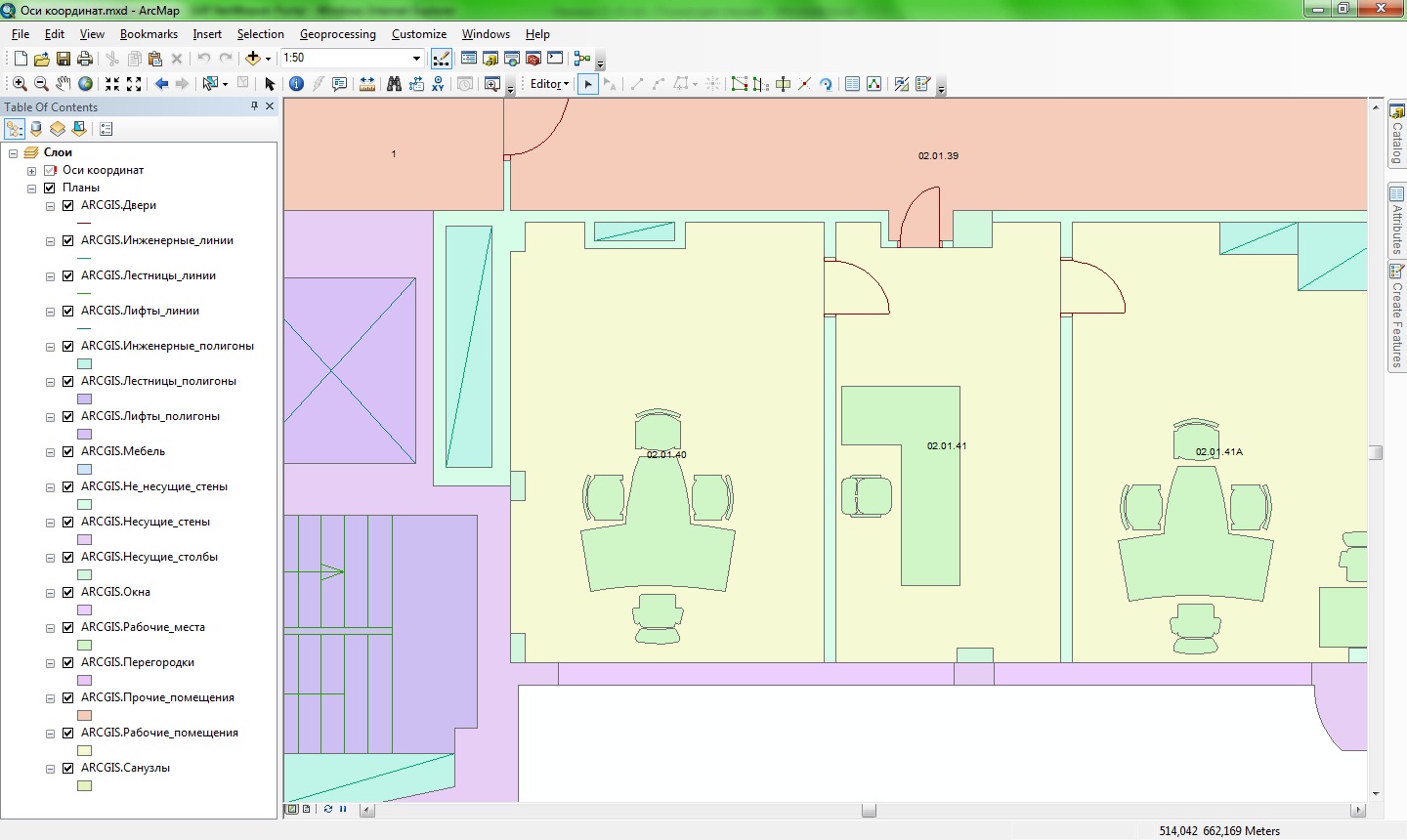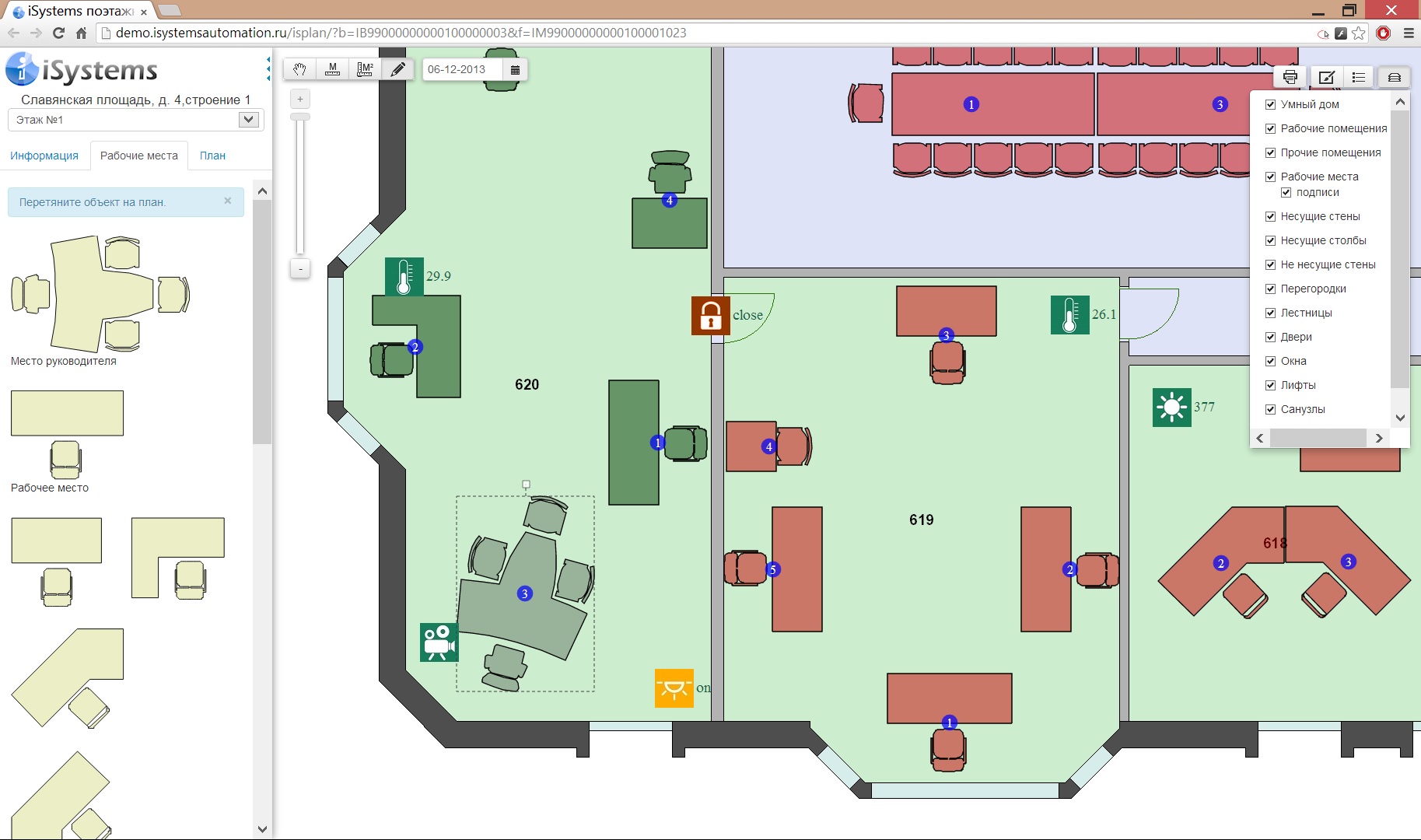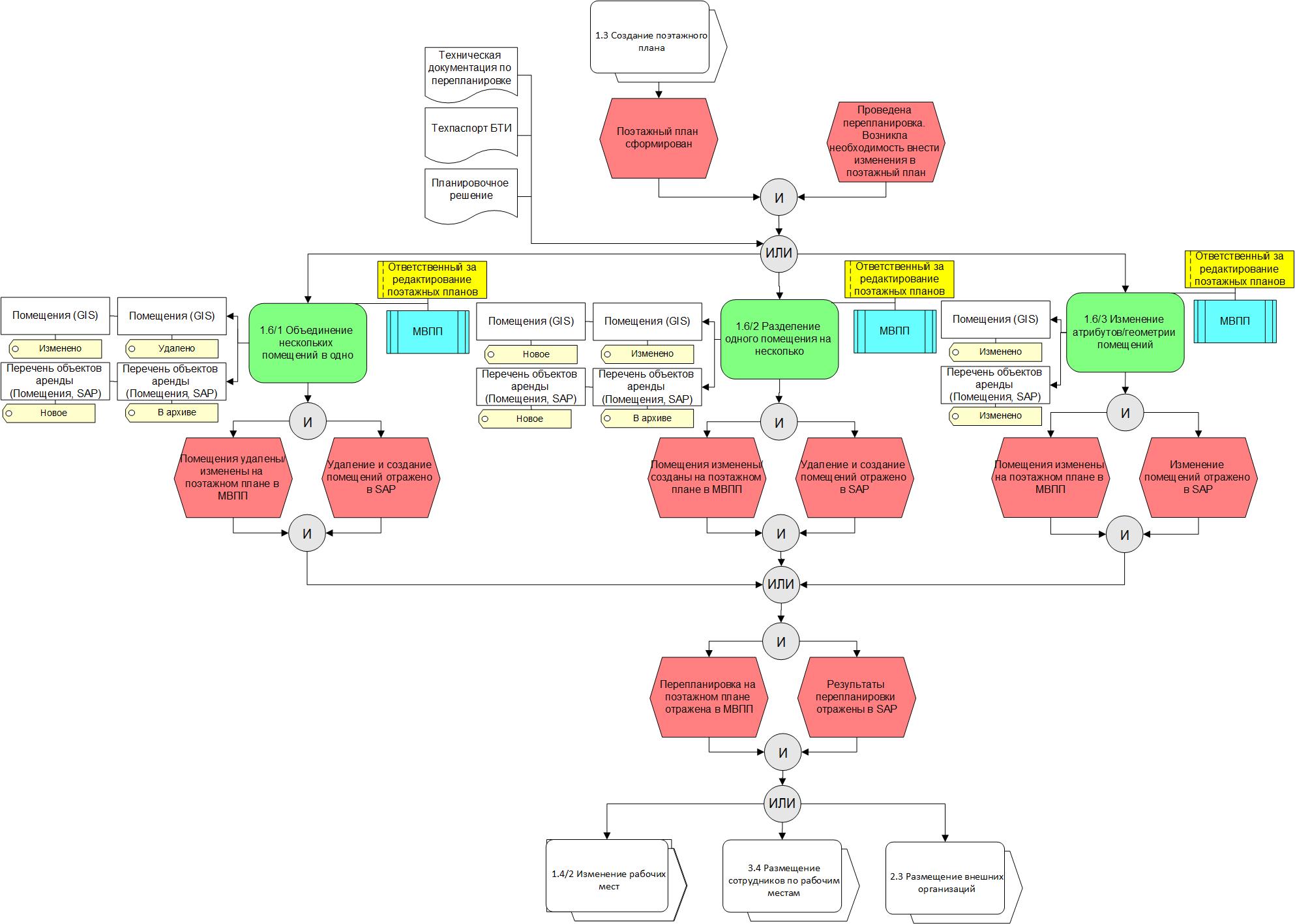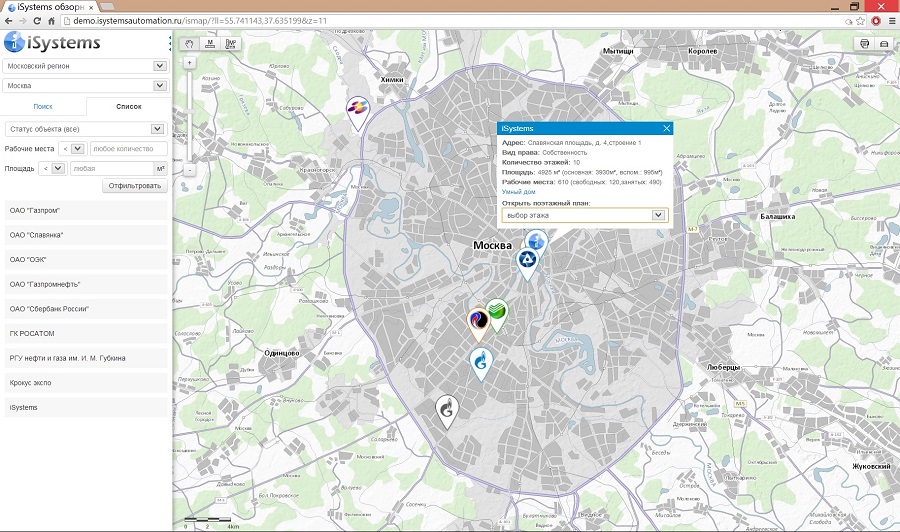Visualization of floor plans or geographic information systems (GIS) in real estate

Earlier on Habré we published an article “From smart home to smart corporations” , in which the Visualization of floor plans (MVPP) module, which we implemented as part of the creation of the Automated Real Estate Management System, was mentioned. Using the MVPP open on the tablet , we could remotely monitor the readings of various sensors installed on the layout of the Smart Home, get a video stream from surveillance cameras, and also control the lighting and the operation of the fountain. Now, I would like to elaborate on the main features of this module and briefly talk about the possibilities of connecting a geographic information system with an enterprise management system.
MVPP- This is the basis that allows you to implement quite extensive functionality on its base. Any object with a set of its characteristics has a spatial reference inside the building. Any number or “quantity of something” can be tied to a building, floor or premises, and subsequently, based on these data, build visual analytical reports.
When implementing integration with other enterprise information systems, for example, with ERP, the MVPP allows you to display relevant information:
- a workplace in the room where Ivan Ivanov is located (with his photo, information about his position, unit and phone);
- the room where the air conditioner with the serial number SN777 is located;
- premises in which the standards for the placement of employees are violated (by any criterion, whether it is the norm of area, ventilation, etc.);
- premises in which a timely check or replacement of fire extinguishing equipment has not been carried out;
- a workplace in the room where it is necessary to replace a broken telephone; this is especially true in Open Space;
- the profitability of a particular division of the enterprise in relation to the area it occupies - suppose that, taking into account the expenses incurred for operating and so on, “department A”, loaded at 100% and occupying 1/3 of the floor space, brings the company more profit than “department C” , loaded at 50% and occupying 2/3 of the room.
By laying down certain algorithms in the GIS MVP, various modeling tasks can be performed, for example, automatic selection of free areas / workplaces or placement of employees in accordance with the “compatibility matrix”. An example of a simulated task: employees of "department A" should be placed closer to "department B", but it is categorically not recommended to be placed in the same room with "department C".
Visualization of floor plans may be an entry point for applying to ServiceDesk. Thus, any user, having previously logged in to the system (thereby identifying himself and his location), simply writes in the special field “The air conditioner has broken - I'm hot” and all the information necessary for initiating the incident is transferred to ServiceDesk - name of the author, his contact details data, place of incident, application text.
MVPP Automated Real Estate Management System is designed for a wide range of tasks, including:
- Visualization and editing the geometry of the floor plan;
- Visualization and editing of workplaces;
- Display of attributive information (by buildings, floors, rooms, workplaces and technological places) stored in SAP;
- Editing attribute information and saving it in SAP;
- Construction of various analytical reports;
- Planning for redevelopment of premises and placement of employees.
MVPP is implemented using Java / JavaScript technologies and published on the Apache Tomcat web server, the server part of the visualization module uses ESRI ArcGIS for Server, and Oracle with an extension for working with spatial data is used as a DBMS. In addition, several Add-In modules have been developed for ArcGIS for Desktop that are responsible for authorizing the user according to the role model and editing geometry of floor plans.
At the initial stage, the spatial database contained the following set of layers:
- Bearing walls;
- Bearing pillars;
- Not bearing walls;
- Partitions;
- Doors
- Stairs
- Window;
- Lifts
- Furniture;
- Engineering systems;
- Workplaces;
- Bathrooms
- Working premises;
- Other premises.

However, due to the emergence of new tasks that will be solved using the MVPP, the data structure will also expand.
The MVPP implements a library of typical workplaces, consisting of ~ 20 different configurations (naturally, in a large-scale series unified with the floor plan). Adding a workplace to the floor plan is carried out by simply dragging it from the library to the desired room. At the same time, on the basis of spatial analysis, the MVPP determines in which room the workplace was installed, which it is in a row, and writes for this workplace in the spatial database all necessary attribute information (building, floor, room identifiers, its number, etc.) . Subsequently, if necessary, the workplace on the floor plan can be moved, rotated, changed its attributes or deleted.

In the property management module of the SAP system, the premises have, among others, the following attributes (indicators) - the actual number of jobs and technological places. In the current implementation, when adding new workplaces to the premises or deleting them, the values of the corresponding indicators in SAP change automatically - i.e. there is no need to calculate the total number of jobs of each type in the premises and then change the values in the corresponding indicators in SAP manually.
SAP has implemented several developments (functional modules) that are responsible for processing the request received from the MVPP, generating and transmitting the requested information to the MVPP. To ensure the integration of the MVPP with SAP, the functional modules are designed as web services (based on SAP ESA) and two-way exchange of information is carried out by XML - packages using the secure SAP SSO2 protocol. In order to be able to launch functional web services, MVPP users need to log in to the SAP system through a technical web service with an additional security loop and authorization check.
The main tasks of the developed functional modules are as follows:
- user authorization and determination of his authority in the MVPP according to the role model maintained by SAP;
- selection of attribute information in SAP with a list of real estate objects, and its transfer to MVPP;
- selection in SAP of attribute information on the selected floor of the property (including information on employees placed at workplaces) and its transfer to the MVPP;
- automatic entry into the SAP database of changes about the results of editing objects through the MVPP (including the creation / removal of premises and workplaces).
Since the main focus in this article I wanted to do specifically on the implementation of two-way communication between GIS and SAP - I will dwell on the last point in more detail. Below is a diagram of the process “Change in floor plan based on the results of redevelopment”. A special case of redevelopment is the combination of two or more rooms into one (or the division of one room into several).

As a result of this process, using the MVPP tool, information is automatically aligned on the changed objects in SAP. However, it should be understood that when the “Delete” operation is performed, neither the SAP nor the GIS deletes anything - the object is locked in SAP (the status of the master data is locked, etc.) for a certain date, similar to the restriction of “deleted” objects a certain date occurs in the spatial GIS database. This allows us to save the history of changes and, if necessary, display in the MVPP both the floor plan that is relevant for a certain date, and information about employees placed at workplaces at any time in the past. In a similar way, the planning process for future redevelopment and placement of employees, i.e. taking the floor plan as a basis for any floor plan, You can plan its future layout. Subsequently (either after the approval procedure, or according to the actual redevelopment, or according to another event), the planned planning can be transferred to the actual status. At the same time, all necessary changes to SAP (removal of premises, creation of new premises with filling in attribute information on them, etc.) will be made automatically by means of the implemented development based on information about changes made to the floor plan in the MVPP. In a particular case, in a similar way in SAP there is also an automatic relocation of employees in the reconstructed premises. At the same time, all necessary changes to SAP (removal of premises, creation of new premises with filling in attribute information on them, etc.) will be made automatically by means of the implemented development based on information about changes made to the floor plan in the MVPP. In a particular case, in a similar way in SAP there is also an automatic relocation of employees in the reconstructed premises. At the same time, all necessary changes to SAP (removal of premises, creation of new premises with filling in attribute information on them, etc.) will be made automatically by means of the implemented development based on information about changes made to the floor plan in the MVPP. In a particular case, in a similar way in SAP there is also an automatic relocation of employees in the reconstructed premises.
MVPP includes two interfaces - an overview application in which real estate objects are displayed on the map with their brief characteristics, and an interface for working with floor plans , which displays various objects on the floor plan with their detailed characteristics. I repeat that all attribute information at each request is transferred from SAP, and not stored in the spatial database.
In the overview application, you can perform the following functions:
- select the region of interest;
- Find a property on the map by name or address;
- filter real estate objects by type of ownership (rent, property, etc.);
- filter real estate objects based on the "<" or ">" number of jobs and / or area of the object;
- display detailed information on the selected (-s) real estate object (-s) (the number of free / occupied jobs, the area of allocated objects, etc.).

In the found property, the user can select the floor of interest, which opens a new window with a floor plan. The following functions are available in this interface:
- viewing the location of workplaces in the room;
- viewing information about the employee occupying the workplace (name, position, unit, date of placement, etc.);
- editing jobs (adding new RMs, deleting or moving free RMs);
- color differentiation of rooms for various purposes (work, bathrooms, stairs, etc.);
- viewing information on the premises or group of selected premises (number, area, design capacity, actual number of free and occupied places, etc.);
- editing of attribute information on the premises (all changes are transferred and saved in SAP);
- color and symbolic identification of jobs based on:
- belonging to an organizational and structural unit (three-level organizational structure)
- employment (free - busy)
- type of use (working - technological)
- color differentiation of walls by type (capital, partitions, etc.);
- measurement of distances and areas;
- creation of planned versions of layouts and placement of jobs;
- printing a floor plan with the output of information about the quantity in accordance with the signs of the lesson.

In conclusion, I want to say that such an unusual, at first glance, cartographer, use of a geographic information system is actually not something out of the ordinary. GIS allows you to navigate in space - but why are our buildings, floors and premises not space ?!
GIS allows you to display objects on the map - we place various types of workplaces and other technological objects with many attributes in the premises, the premises themselves on the floors. To one degree or another, on floor plans, we use elements of spatial analysis, search or geo-processing - everything is just like in a large GIS, unless, for now, we have the function of calculating routes inside buildings ... TILL.
